Acting Up a Storm
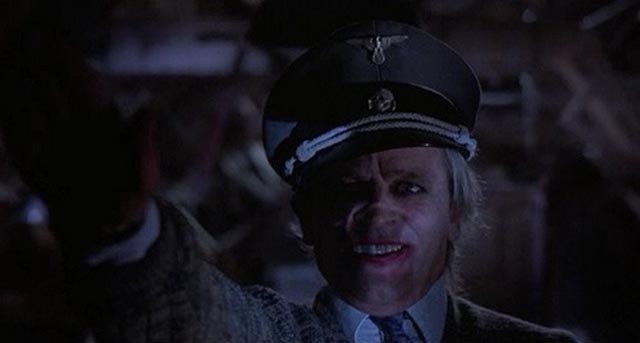
One thing I observed on the set and around the studio when I was in Mexico in 1983, working (peripherally) on Dune, was a general difference between the American actors and the Europeans. There was a calm, matter-of-fact attitude about the latter, a view that acting was a job and they’d signed on to do it, while many of the Americans in the cast were prone to display ego, to be loud in restaurants, calling attention to themselves. It was clear in some of them that this was at least in part due to insecurity – some of them were classically “Method”, needing to inhabit their character, while the Europeans took on their roles as clearly defined tasks, a matter of skill and technique rather than “being”. I particularly recall one day when Jack Nance found me in a corner of a soundstage, ducking out of the way of Brad Dourif whom he clearly found exhausting (David Lynch was hoping at the time to cast Jack and Brad as the two scientists in Ronnie Rocket – if he ever managed to get the project off the ground). On that particular day, Brad was struggling to find his character inside himself – but where do you find a super-intelligent, spice-addicted Mentat in a West Virginia boy? Jack couldn’t take any more of the angst and artistic struggle; his philosophy was “you say the words and you make the funny faces.” That is, he was much more aligned with the Europeans who viewed acting as a craft and not an existential state of being.
This split also exists generally between “stars” and “character actors”, between those whose roles must be bent to fit their pre-existing persona and those who disappear into whatever role they’ve signed on to play. Interestingly, many European stars behave more like character actors – on Dune, Max Von Sydow, Jurgen Prochnow and Patrick Stewart were low-key, businesslike, getting the job done as efficiently as they could without making any fuss, while, say, Kenneth MacMillan was working himself up into a storm of energy-driven attitude as Baron Harkonnen. And Sylvana Mangano, as the Mother Superior, had a kind of ethereal calm as she floated onto the set, delivered her few lines, and drifted away again …
Perhaps it’s this long-standing practical view of acting – it’s a craft, a way of making a living – which has made some of the finest European actors take parts in movies a “real star” would avoid. (Just picture Von Sydow, Bergman’s alter ego in so many dark and arty films, as the Emperor Ming in Mike Hodges’ campy Flash Gordon.) Performers like Klaus Kinski and Udo Kier have the kind of presence which distinguishes a star, too oddly distinctive perhaps to blend into the scenery and disappear into a role – regardless of one’s judgement of them as actors, they’re fascinating to watch and dominate the films they star in and usually steal the scenes they play in smaller roles. And both have appeared in roles of every size – Kinski in over 130 in 40 years, Kier in over 200 in almost 50 years. When they star, any film forms itself around their personality; when they appear in a supporting role, they add a distinctive flavour which elevates even a mundane project. But most of all they work (or in the late Kinski’s case, worked) endlessly; it’s what these actors do, who they are.
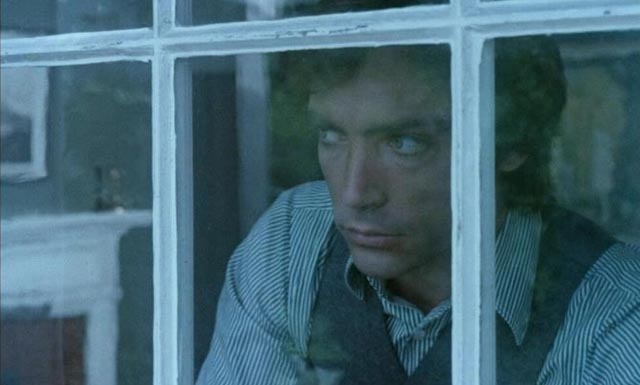
Udo Kier in The House On Straw Hill (1976)
Kier already had Michael Armstrong’s Mark of the Devil (1970) and Paul Morrissey’s Flesh For Frankenstein (1973) and Blood For Dracula (1974) behind him when he signed on to star in James Kenelm Clarke’s The House on Straw Hill (1976, aka Trauma aka Exposé). Clarke had a fairly brief directing career, starting with some BBC documentaries for a program called Man Alive which apparently dealt with religious and spiritual subjects. The House on Straw Hill, his second feature, was a piece of overt exploitation with some pretense of style, but not much narrative drive.
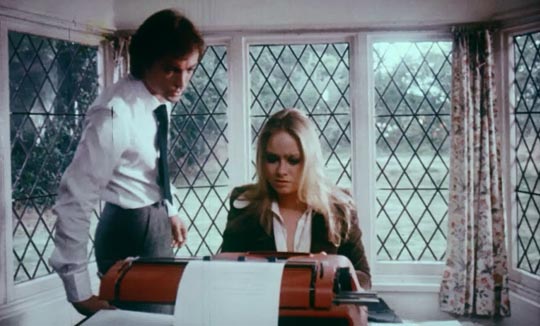
Udo Kier plays Paul Martin, a writer whose first novel was a big success, but who is now struggling to write the follow-up in a remote country house. He has an expensive and demanding mistress (played by Brit sex star Fiona Raymond) and is getting a lot of pressure from his agent and publisher to finish the book. To help with the writing, a new secretary is hired (Linda Hayden, best known for her precociously sexual teenager in Piers Haggard’s The Blood On Satan’s Claw [1971]). The movie is rife with sexual tensions (Udo slips on latex gloves before bouts of hot, sweaty sex with his mistress; the secretary spies on the pair going at it and later seduces the mistress in front of the writer), and dreams and fantasies and possible hallucinations intrude – sex, blood, a man lurking outside the house. The secretary is raped by a pair of local thugs and blows them both away with their own shotgun. It’s a toss up who’s craziest, the writer or the secretary, but it eventually turns out that she’s insinuated herself into his life to get revenge; that first successful novel was actually written by her husband who killed himself when the success was stolen by Martin.
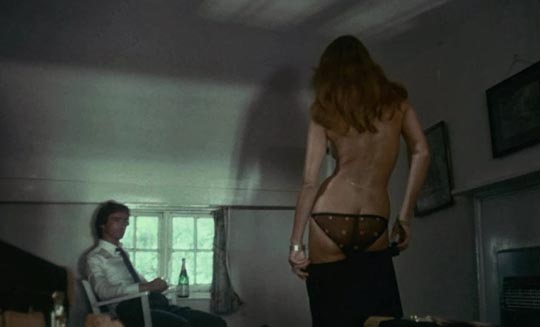
The House On Straw Hill is quite well shot (though the disk’s source materials are in rough shape), but rather dull despite the nudity and occasional bursts of bloody violence. Its most severe failing, however, comes from Udo Kier being stripped of his own voice. He was dubbed with a vague mid-Atlantic accent and the disconnect between the actor’s familiar, distinctive face and the sound apparently coming from his mouth destroys any chance of establishing the atmosphere of psychological tension and horror the film is striving for. It remains a minor, forgettable footnote in Kier’s long career.[1]
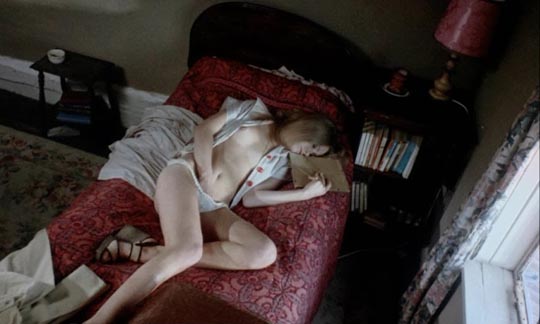
Severin’s Blu-ray, on the other hand, does have some interest. There’s a commentary track by Clarke and producer Brian Smedley-Aston which is quite illuminating about low-budget filmmaking in England at the time: the presence of Richmond is due to some of the financing coming from Paul Raymond, England’s attempt to duplicate Hugh Hefner and the Playboy empire. Richmond was Raymond’s partner and he essentially bought her the role despite the fact that she had no acting talent (her fame rested mostly on the nude photos of her which filled Raymond’s various slick sex mags). Clarke and Smedley-Aston (and commentary moderator Jonathan Sothcott) not surprisingly have a higher opinion of the film than I do, but the oddest thing on the track is their assertion that Udo Kier was dubbed with someone who perfectly emulated his voice – just a bit less “European”.
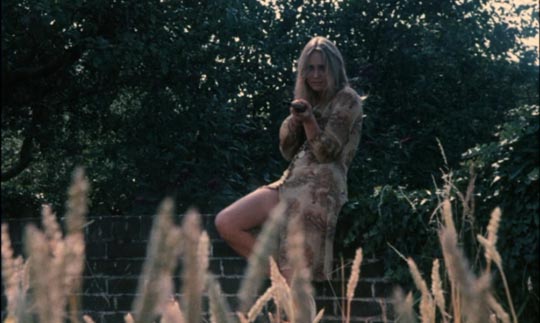
There’s also an interview with Linda Hayden (imported from Anchor Bay’s 2003 region 2 DVD of The Blood On Satan’s Claw) in which she talks about her career and shows no affection for this particular movie; some of her assertions are disputed by Clarke and Smedley-Aston, but it’s obvious she dislikes the film intensely.
The limited, special edition also includes an additional disk containing Ban the Sadist Videos! (2005-6), a two-part documentary about the video nasty mania in ’80s Britain. You have to have some sympathy for director David Gregory; he covers the same ground as Jake West three years later in Video Nasties: The Definitive Guide (2009), with many of the same people interviewed and similar arguments made, but West’s documentary is better crafted and more focused. Still, there are details and voices unique to Gregory’s program, so it makes a worthwhile companion piece for the later doc.
*
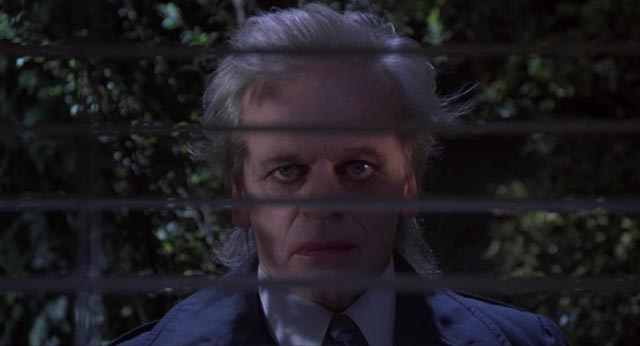
Klaus Kinski in Crawlspace (1986)
Although David Schmoeller has worked quite steadily for the past thirty-five years, he’s probably best known for his first feature, Tourist Trap (1979), about which Stephen King was enthusiastic in Danse Macabre, his 1981 survey of the horror genre. Somehow, in 1986, Schmoeller managed to get Klaus Kinski for the lead in his small horror feature Crawlspace. This was just a year before Kinski’s final collaboration with Werner Herzog, Cobra Verde (1987), and five years before the actor’s death. Taking the role of a creepy landlord with dark secrets, who preys on his uniformly young and female tenants, wasn’t such an odd choice on his part. Outside of his intense work in five films for Herzog, Kinski had mostly had supporting roles, often in minor genre movies or misfires like Piers Haggard’s Venom (1981) and William Malone’s Creature (1985). He seemed to be attracted to roles in small films which offered the promise of some interesting scenery to chew – Jess Franco’s Jack the Ripper (1976), Aaron Lipstadt’s Android (1982) … and Schmoeller’s Crawlspace. Kinski’s Karl Gunther runs a rooming house which caters solely to young women – he drives off male applicants with a crazed look. But then, he accepts young women applicants with an equally crazed look, combined with such a blatant leer that it’s impossible to believe anyone would actually rent a room from him. But that kind of plausibility is irrelevant here; the film needs nubile victims, so the girls sign their leases.
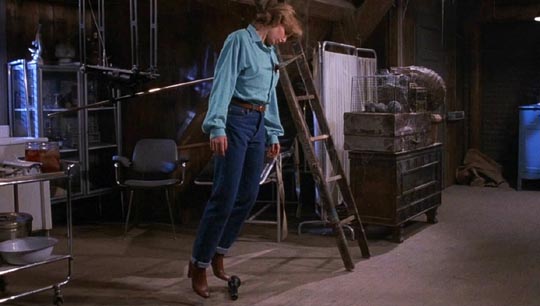
There’s very little story. Karl prowls the building, slithering through rather large ducts in the walls and ceilings, spying on his tenants and retreating to the attic room where he keeps a former tenant in a cage, a captive audience for his long monologues rooted in the Nazi past (yes, Karl’s father was a camp doctor who conducted heinous experiments). Karl dresses up and projects old Nazi newsreels … and occasionally kills a tenant, or an intruder who gets too close to his secret. It’s all nonsense, but Kinski revels in it and holds the viewer’s fascinated eye for the entire breezy 80-minute running time.

… except a hand over open flame
But the best thing on Shout! Factory’s Blu-ray is a short made by Schmoeller in 1999 called Please Kill Mr. Kinski. This funny, self-deprecating account of the making of Crawlspace is Schmoeller’s version of Herzog’s documentary My Best Fiend (also 1999). We know from Herzog’s film what a nightmare working with Kinski could be, but the archival clips of the actor making his director’s life miserable on the Crawlspace set are priceless and the details Schmoeller recounts of his torment give you some appreciation for the finished film which you might not have otherwise had. The power of Kinski’s acting was inseparable from his impatient madness and his provocations probably improved what otherwise would have been a forgettable little genre movie. Crawlspace might not be much, but Kinski twisted it into a reflection of his own image and there are few things as interesting to watch.
*
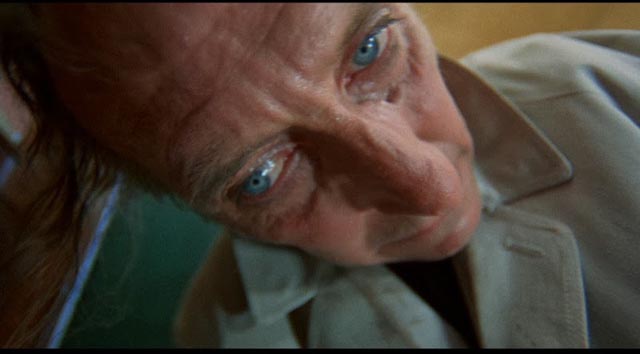
Peter Cushing in Corruption (1968)
Unlike Kier and Kinski, Peter Cushing was a classically-trained English theatre actor who entered movies playing bit parts in his mid-20s. In 1948, he played Osric in Olivier’s Hamlet; in 1954, Winston Smith in the Nigel Kneale-Rudolph Cartier BBC adaptation of Nineteen-Eighty-Four; and then in 1957, the course of his varied career shifted dramatically when Hammer Films cast him as the title character in The Curse of Frankenstein. Although he still continued to play a variety of roles, he became indelibly associated with horror – both as mad and misguided scientists blindly violating nature’s laws and as no-nonsense experts fighting against supernatural horrors. He himself said he considered Van Helsing in the Dracula movies to be more insane than Frankenstein: after all, he traveled about with a bag full of sharpened sticks and a mallet for driving them into people’s chests.
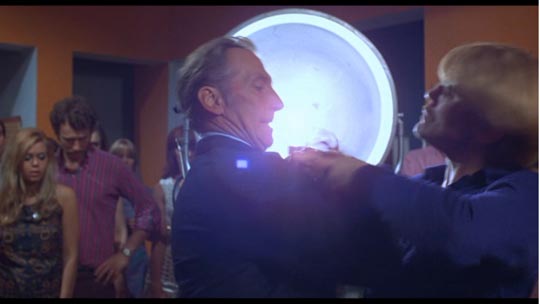
But in all of this, and despite a fairly widespread disgust among “people of taste” for the violence, perversion and gore of Hammer’s signature horror films, Cushing maintained an air of seriousness and dignity, even with his arms up to the elbows in blood and organs. He was known as a pleasant, cultured gentleman in his private life and that air of dignity informed all of his screen work (and was used as a very effective device in films like Quentin Lawrence’s brilliant little B thriller Cash On Demand [1962], in which a very skillful con-man uses the deeply-rooted, humourless rectitude of Cushing’s provincial bank manager to draw him into a plot to rob his own bank). Like so many busy working actors, Cushing took jobs in numerous films which by any objective standard were probably not worth the effort, but even in the most risible of these he maintained a remarkably committed professionalism. He never phoned it in, never mocked the material he was asked to invest his talent in.
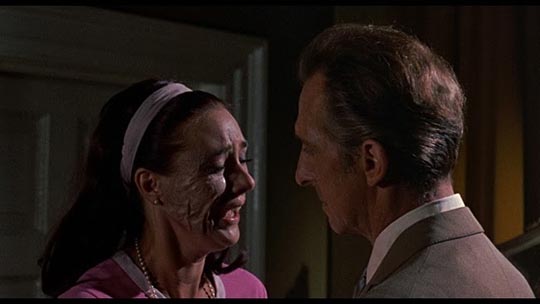
And yet, despite this history, I was taken completely by surprise when I recently watched Robert Hartford-Davis’ Corruption (1968, aka Carnage) on Grindhouse Releasing’s new, extras-packed Blu-ray. Hartford-Davis wasn’t much of a director, but here in what was probably his best-directed movie he turns the core idea of Georges Franju’s poetic Eyes Without a Face (1960) into an increasingly bizarre and decidedly sleazy exploitation movie. Famous surgeon Sir John Rowan (Cushing) is obsessed with his younger, glamorous fiancee Lynn Nolan (Sue Lloyd), who moves in the amoral fashion world which has little in common with his staid middle-class values. Although the script by Donald and Derek Ford can find no way to make their relationship even remotely convincing, everything hinges on his obsession and Cushing does his usual committed best to make the character plausible.
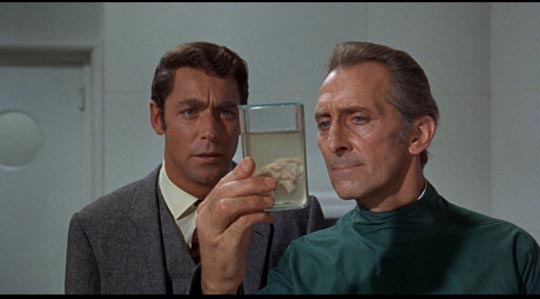
When he reluctantly accompanies Lynn to a “swinging ’60s” party, he’s completely out of his depth among the hedonistic young crowd and tries to drag her away. But she sloughs him off, starts stripping off her clothes and gets in front of the camera of sleazy photographer Mike Orme (Anthony Booth). Sir John, his sense of propriety deeply offended, gets into a fight with Orme during which a large photo light falls and lands on Lynn’s face, severely scarring her … and of course ending her modelling career.
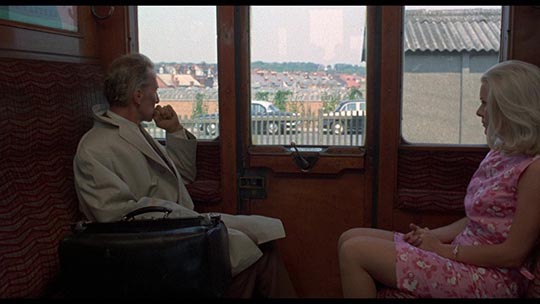
Sir John’s researches into skin regeneration lead him to discover a formula which can restore Lynn’s face, the key ingredient being extract of pituitary. But it turns out that the effect is only temporary … and further, that it lasts longer if the juice is extracted from a very freshly dead (or still living) victim. And so Sir John becomes a serial killer (not surprisingly, given the genre, of women) while his increasingly bitter and demanding fiancee spurs him on to ever more risky crimes. So far, not too different from some of Cushing’s other work.
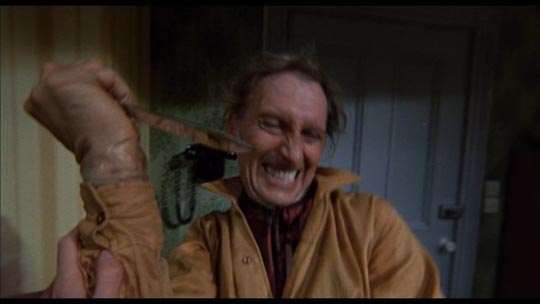
But then we get to the scene in which he visits a prostitute in Soho. She gets a bit irritable as she strips off and he just stands there undecided by the bed. Then he pulls out his big surgical knife and attacks her. And suddenly we get the spectacle of the as-always dignified, 55-year-old Peter Cushing rolling around on the floor with a virtually naked woman. It’s a true measure of the man’s innate sense of composure that he gets through the scene in character, without any overt signs of self-consciousness. In fact, he acts up a storm as his own violence deranges him (this madness increases with each subsequent murder). But, while he would later solemnly inspect fang-punctured breasts in The Vampire Lovers (1970) and Twins and Evil (1971), I believe Corruption stands as his most physical encounter with the nudity which was becoming more common towards the end of the ’60s and although it’s tempting to feel somewhat embarrassed on his behalf, he never betrays any obvious reservations about what he was being asked to do on camera (though later in life he would call Corruption one of the two worst movies he’d ever been involved in) … and, in fact, he even worked with Hartford-Davis again two years later in the eminently forgettable Bloodsuckers (aka Incense For the Damned).
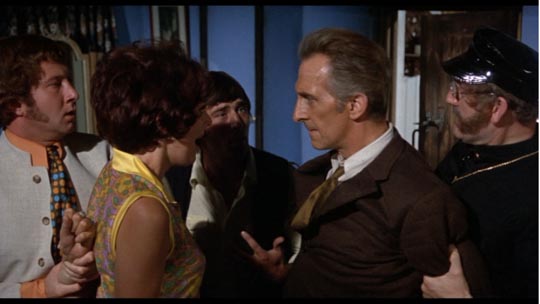
The pristine HD transfer on the Blu-ray perhaps does the film more justice than it deserves; the photography by Peter Newbrook (director of the effectively strange The Asphyx [1973]) is bright and colourful, providing a nice contrast with the gruesome goings-on. And given the sordid, and for the time extreme, events depicted, the cast is surprisingly good – even when we get to the climactic home invasion by a ludicrous gang of “beatniks”, everyone remains committed. The disk commentary by Jonathan Rigby and Cushing biographer David Miller is lively, observant, and informative; and several short retrospective interviews with some of the cast add some interesting notes about the production.
_________________________________________________________________
(1.) Two personal notes relating to The House on Straw Hill: the movie was shot about 15 miles from where I was born in Essex. And three years ago, Kier was in Winnipeg working on Guy Maddin’s Keyhole. One evening I was sitting with a couple of friends in the Elephant & Castle, a faux English pub, and happened to look across at the bar. It was one of those double-take moments. There was a man walking past towards the rear and it abruptly registered that he was none other than Udo Kier. And he happened to turn and glance my way at just that moment. Eye contact. He registered that I had recognized him, then went on his way. I discussed briefly with my friends whether I should go back and talk to him, but I chickened out. It was only later that I heard from people who’d worked on Keyhole that he was very approachable and actually liked people to recognize and talk to him … one of those missed opportunities that you kick yourself about for years. (return)
Comments
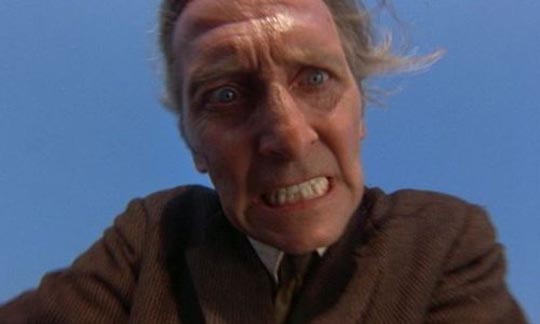
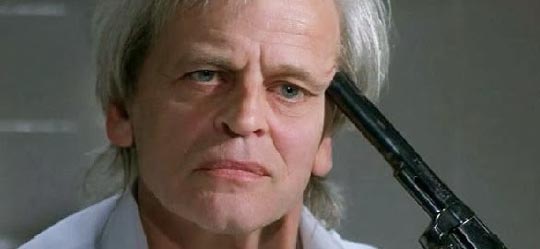
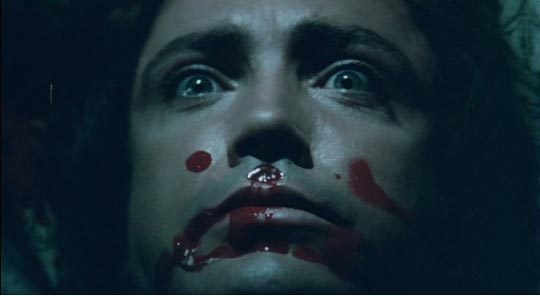
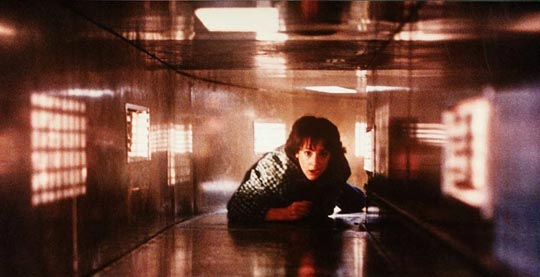
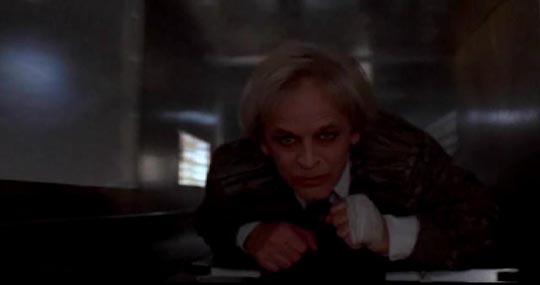
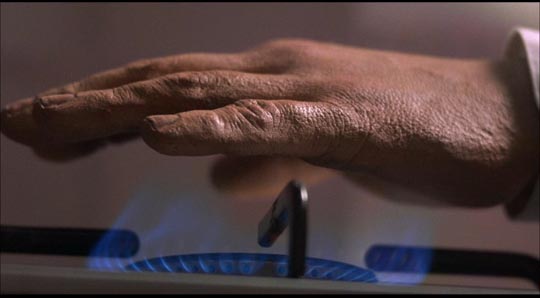
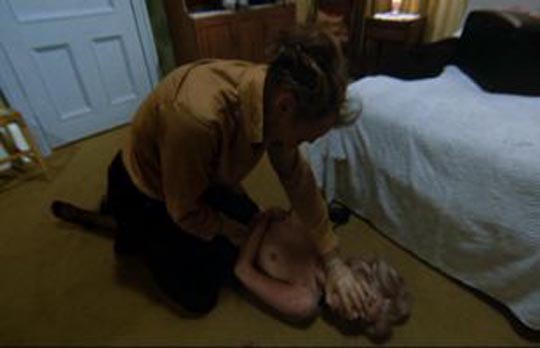
My favorite actor, Kate Blanchette, apparently avoids artistic affectation.
Although more flamboyant, Jennifer Lawrence also seems real.
Maybe it’s the quality I’ve noticed often in the best athletes on the field – generally they’re relaxed and enjoying themselves.
I assume I’ve told you the Paul Scofield “my fly” anecdote?
No, I don’t think I’ve heard that one.